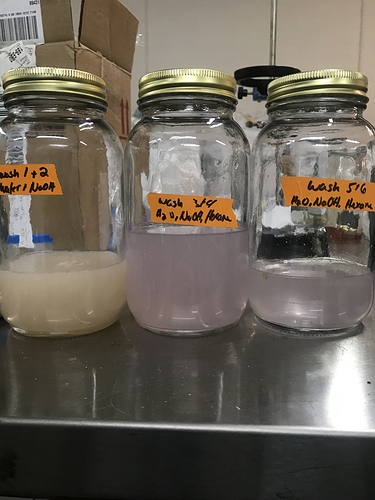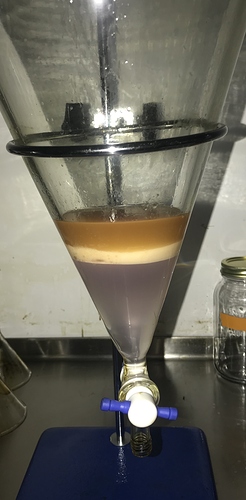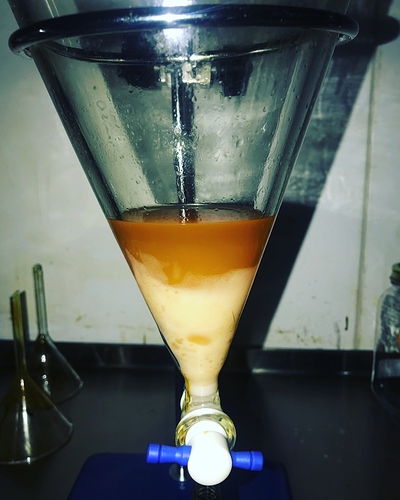So I tried this experiment with the hope of removing THC from CBD distillate under the following conditions:
- Distillate dissolved in Hexane (3hex:1dist) by mass
- Add aqueous phase to funnel (1aqu:1dist mix) → aqueous phase composed of NaOH+H2O @pH12
- shake funnel gently to get everything mingling
- allow time for phase separation
- remove aqueous phase
- repeat aqueous wash on remaining organic phase until wash comes out clean
- roto
I have no idea what I’m doing… I followed the Future 4200 rule of reading until I can’t remember what I came here for, and then throwing all that knowledge into some form of an experiment. And this is what I came up with…
- These are my wash collections, I don’t know why the first one is milky and the last two are pink (I combined was 1+2, 3+4, 5+6 because I don’t have enough glassware
 )
)
-This is the product in the sep funnel after wash 5+6. You can see the aqueous phase is super light, but I don’t know why we have an emulsion layer
-Then something spooky happened with the next wash. I added more aqueous solution to do a 7th wash but instead of separating into distinct layers like the previous photo, I got this
-So I removed the bottom layer and roto’d the coffee looking organic phase… and now I have this
Anyone know what happened? I’m waiting for lab results to see if we actually pulled any THC, but at this point I don’t even care. I’m more interested in figuring out what happened here and how to get back to a pretty looking distillate.
Anyone?
2 Likes
Perhaps the strong base saponified some fat in the oil making a crude detergent
5 Likes
I think you’ve invented latte dabs
Unfortunately the person who’s thread you’re replying to is no longer with us. There’s a number of LLE discussions that have popped up recently
7 Likes
Any idea of what to do from here?
@ObxLabs. It works ive done it and the added bonus is water solubles and terps are removed. Works really good in between 1st and 2nd pass
2 Likes
So the pH 12 will move your acidic cannabinoids into the water (thc-a & cbd-a). If you neutralize the water they should precipitate.
Your other layer might be a mix of fats and waxes and stuff
4 Likes
Unfortunately this was all distillate, already decarbed so I don’t expect to have any acids in the water.
I think you are right about the coffee layer. I suppose I should try winterizing then?
1 Like
Did you thoroughly dry and neutralize the solution before you roto’d it?
I’m guessing no because I don’t know what you mean by “dry” it. And no, we did not neutralized it.
What is the purpose of neutralizing the organic phase? I’ve only heard to neutralize the aqueous phase
1 Like
Not neutralizing before distillation causes isomerization issues. Not drying your organic phase before evaporsting rhe solvent will leave you with an extract with water in it. Your roto probably mixed the extract into the consistency of butter by removing the solvent but not the water from solution.
You dry as a final step before solvent evaporation to avoid getting water in your extract. You can use many sifferent desiccants for this purpose.
2 Likes
Ah yes, I was reading about this over the weekend.
Thank you, this is super valuable info.
If that doesnt work @ me, ive got another trick up my sleeve for this kind of thing.
2 Likes
Ugh yes, I love people who want to help. Thank you, and let me know if you ever need a hand from me or @outlander – we’re all about community and leveling up together.
2 Likes
I always rock a salt water wash on my alkane/cannabinoid layer to mitigate water
3 Likes
What does the salt wash actually do? I was just talking to my partner about it - sometimes it’s regular water and other times salt water.
Can someone explain why you would want one over the other in certain situations?
1 Like
If someone who’s better at chemistry wants to correct me feel free. But basically, regular water is nearly immiscible in alkanes, but not fully immiscible. So there will be trace amounts of water bound to the Pentane/heptane/whatever. The salt forms a stronger bond than the alkanes does, so the salt “pulls” the trace water away from the alkanes and effectively “dries” it.
7 Likes
Actually this full circles a lot for me.
the puzzle is finally taking shape, thank you
From paper linked above:
This salting out often occurs at high salt concentrations. In some cases, the “salting-out” (or perhaps better termed “sugaring out”) effect also can be achieved with high concentrations of saccharides (3).
@tweedledew
Meaning instead of having brine to dispose of, we can haz something we can feed to yeast to get more solvent…
Might even save on trace nutes too!!
Sugar, we’s gonna have to try this…
5 Likes
Salt increases the polarity of the aqueous layer, making it less hospitable for non polar (ie cannabinoids) molecules. I don’t think it affects the miscibility of water that’s a different property but the entropy increase of having salt makes water more interested in the aqueous layer… Without doing some annoying math I dunno how big an effect that would be tho
1 Like
 )
)


